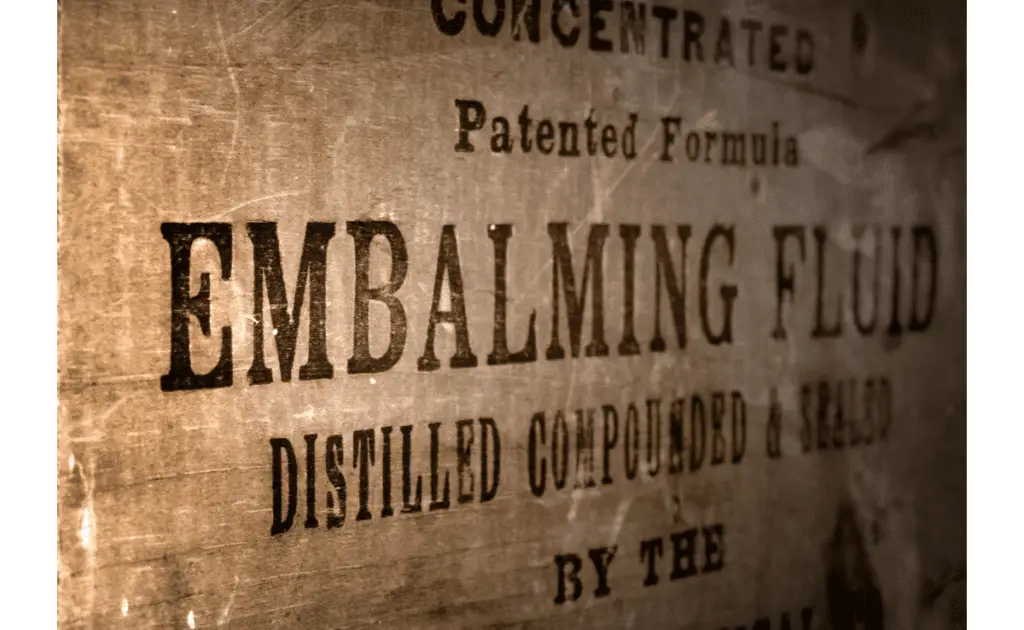
Embalming fluid is a preservative Consisting of formaldehyde, Glutaraldehyde and menthol. The purpose of embalming fluid is to preserve bodies until a funeral or wake can be held. It also allows funeral homes to adjust color to make the deceased appear more lively.
What is Embalming?
Embalming is widely practiced in North America and involves the draining of bodily fluids and introducing preserving fluids into the deceased, to slow down the decomposition of the body. This practice preserves the deceased so that they look life-like for an open-casket viewing. The embalming process only delays decomposition and does not prevent the body from ultimately decomposing. Read our in-depth article here to learn more about the embalming process. So when asked, What is embalming fluid? It is a preserving fluid to delay the inevitable decomposition of the body.
What Does Embalming Fluid Do?
Embalming introduces chemicals into the body to temporarily preserve the tissues of the corpse. In many cases, the funeral can’t be held for at least a week and embalming fluid ensures that your loved one looks their best for the final goodbye. Whether to embalm or not is an individual choice, and if you are wondering what is embalming fluid, we will look at it in more detail.
Embalming solution is injected into the arteries, tissues, and sometimes the organs of the body. It is a specialized process carried out by a registered embalmer, a special license is required to purchase embalming fluids.
What is Embalming Fluid Made of?
Embalming fluid contains strong preservative formaldehyde, often 35% of the mix. Glutaraldehyde a disinfectant makes up 9% to 56% of the embalming fluid and methanol is also present. All the chemicals are known as carcinogens, and if the person wasn’t dead they would be highly toxic to the body. Other substances contained in embalming fluid are:
- Water conditioners to help decrease acidity.
- Dyes improve the body’s coloration and also allow the embalmer to see the distribution of the embalming fluid throughout the body.
- Surfactants or Humectants to improve the appearance of hydration in a body.
- Anti-edema chemicals have the opposite effect from the surfactants and release excess fluid from the body.
The embalmer wears full PPE or personal protective equipment to protect him against the toxic chemicals.
What Does Embalming Fluid Smell Like?
For safety reasons, no one but the embalmer is allowed into the room while the embalming is taking place. Formaldehyde has an anesthetic-type smell, and in the old days it was used to anesthetize people for minor surgery, so if you weren’t using PPE while embalming the Formaldehyde would probably anesthetize you. There is an overall smell of disinfectant in the embalming fluid. If the deceased has died of infectious disease, embalming could be used to prevent the further spread of microbes.
There is a lot of work required before the body is ready for viewing, and the main reason is to present the body at its best on the day of the funeral. The following steps are carried out during the embalming process.
- Laying the body out undressed with the head elevated.
- Checking for any vital signs, like a pulse, or to see if rigor mortis has set in.
- Bathing, the deceased is washed with germicidal and disinfectant solutions
- The face, often a photo is required to get the right expression on the face. The eyes are closed and the jaw wired shut
- Arterial Embalming, is the next step and involves draining the blood vessels.
- Cavity Embalming releases excess gas from organs.
- Hypodermic Embalming, sometimes fluid is introduced into tissues to plump them out.
- Surface Embalming restores the skin surface where an injury may have taken place.
- Moisturizing and Make-up occur
- Dressing in a chosen outfit for the viewing.
The deceased is then placed in the coffin chosen by the relatives for the occasion. Embalming takes about one hour to complete.
Green burials are now becoming popular, and some people choose to go straight into an environmentally green coffin and be buried into the ground following death. The coffin is designed to break down and return the deceased to the earth in time.
What Color is Embalming Fluid?
Embalming fluid is actually colorless, and the medical students become surprised at the different looks of the skin in the deceased.
There are two reasons for this, and when you enter the dissection room all the blood has been drained from the corpse and discarded prior to dissection. The other reason is that many funeral homes add some pink or red dye to the embalming fluid to make the deceased look a better color for the casket viewing. The aim is to achieve a natural skin tone, and this is hard to get right, sometimes they do this by simply applying cosmetics to the face. There are now some natural embalming fluids being developed, and reports from those who have used them say the embalming gives the deceased a more natural appearance as if they are sleeping, and the fluid is non-toxic to those applying it.
Embalming History
To discover what is embalming fluid we need to go back to the ancient Egyptians who developed the process in the First Dynasty. They carried out the procedure very differently from the way we do it now, and the body was covered all over with a substance called Natron. In Europe embalming wasn’t used until much later during the Roman Empire. From around 500 CE during the middle ages, embalming began to develop with the use of embalming fluids. Various attempts and practice were reported by Leonardo Da Vinci around 1500, and others tried to perfect the process. During the American Civil War, embalming became more common in the USA, where soldiers often died far from home. Because the relatives wanted them to be buried at home with their family, embalming became common practice. Embalming experts became common, and it was a business often handed down from generation to generation, like funeral homes. Nowadays, embalmers all have some kind of science degree, as you need to be properly qualified to work with the deceased and they are often known as Morticians.
We all die, and although many people don’t like to think about death, others like to plan their funeral down to the last detail. So if you ask what is embalming fluid, there is plenty of information at hand.

